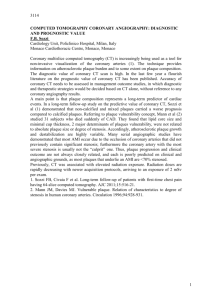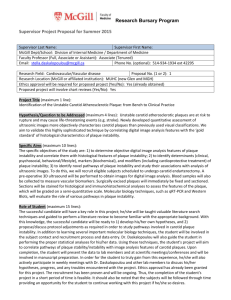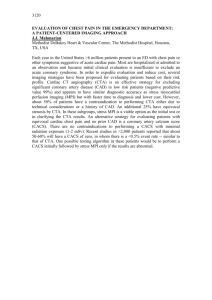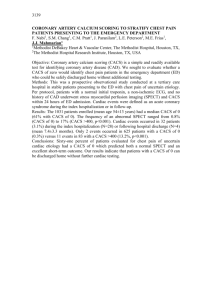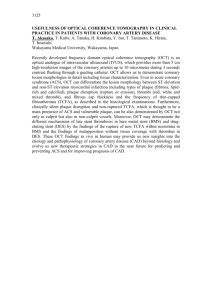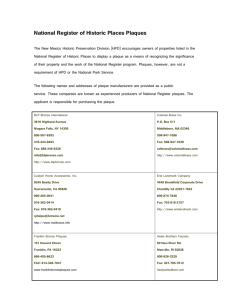Screening For Atherosclerotic Cardiovascular Risk
advertisement
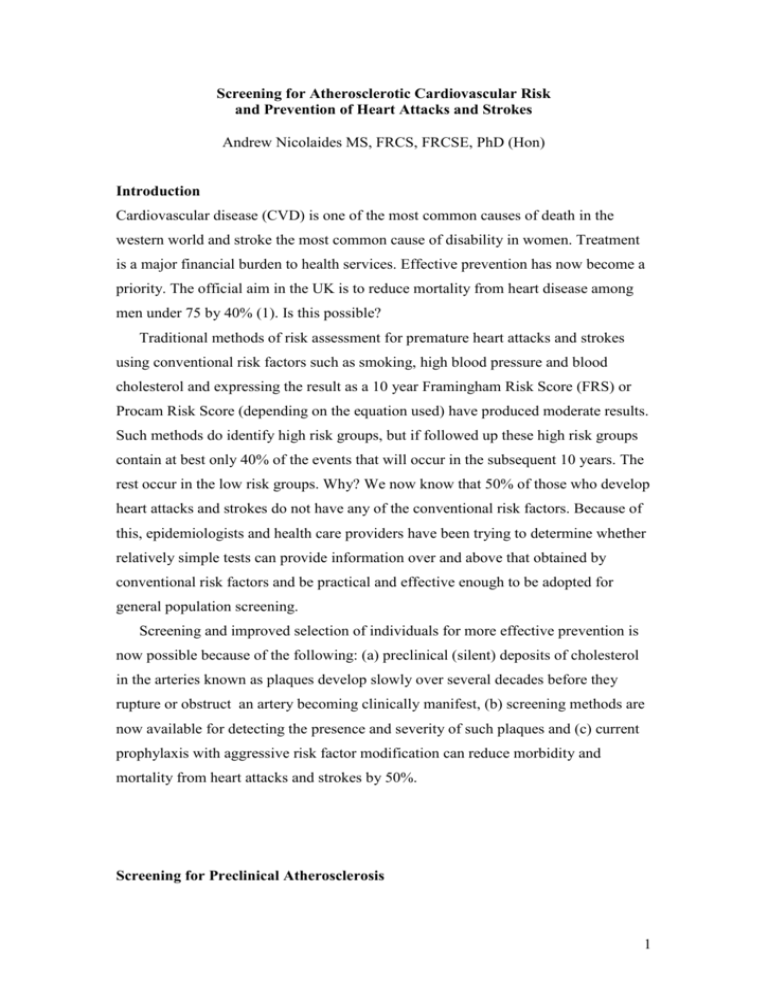
Screening for Atherosclerotic Cardiovascular Risk and Prevention of Heart Attacks and Strokes Andrew Nicolaides MS, FRCS, FRCSE, PhD (Hon) Introduction Cardiovascular disease (CVD) is one of the most common causes of death in the western world and stroke the most common cause of disability in women. Treatment is a major financial burden to health services. Effective prevention has now become a priority. The official aim in the UK is to reduce mortality from heart disease among men under 75 by 40% (1). Is this possible? Traditional methods of risk assessment for premature heart attacks and strokes using conventional risk factors such as smoking, high blood pressure and blood cholesterol and expressing the result as a 10 year Framingham Risk Score (FRS) or Procam Risk Score (depending on the equation used) have produced moderate results. Such methods do identify high risk groups, but if followed up these high risk groups contain at best only 40% of the events that will occur in the subsequent 10 years. The rest occur in the low risk groups. Why? We now know that 50% of those who develop heart attacks and strokes do not have any of the conventional risk factors. Because of this, epidemiologists and health care providers have been trying to determine whether relatively simple tests can provide information over and above that obtained by conventional risk factors and be practical and effective enough to be adopted for general population screening. Screening and improved selection of individuals for more effective prevention is now possible because of the following: (a) preclinical (silent) deposits of cholesterol in the arteries known as plaques develop slowly over several decades before they rupture or obstruct an artery becoming clinically manifest, (b) screening methods are now available for detecting the presence and severity of such plaques and (c) current prophylaxis with aggressive risk factor modification can reduce morbidity and mortality from heart attacks and strokes by 50%. Screening for Preclinical Atherosclerosis 1 Three methods are currently available: (a) measurement of ankle brachial index (ABI), (b) coronary artery calcium scoring (CACS) using multislice CT-scanning known as Electron Beam Tomography (EBT) and (c) ultrasonic arterial scanning.. Each method provides information that can improve the FRS to a lesser or greater extent and has its advantages or disadvantages. This is because the information obtained by each method is related to different characteristics of preclinical atherosclerosis at different stages in time (earlier or later) in different vascular beds with different significance and associated costs. This article summarises the efficacy of each method and associated advantages and disadvantages in an attempt to answer the questions which method or combination of methods and when should be used, and most importantly what advice should be given to individuals once the results become available. Measurement of ABI This consists of measurements of ankle and brachial systolic pressures with a handheld “pocket Doppler” and calculating the ratio of ankle pressure over brachial pressure. This is the oldest and least expensive method. It was introduced in 1969 by the vascular team at St Mary’s Hospital Medical School as a method of assessing the severity of lower limb ischaemia and the response to medical or surgical therapy. Subsequently, it became an epidemiological tool. A recent meta-analysis has assessed the results of 16 general population cohort studies (2) involving 24,955 men and 23,339 women. Asymptomatic individuals without any history of CVD had their ABI measured at baseline and followed up to detect cardiovascular events and mortality. The 10 year cardiovascular mortality in men with low (abnormal) ABI (≤ 0.90) was 18.7% and in those with normal ABI (1,11-1.40) was 4.4% (Hazard ratio [HR] 4.2; 95% CI 3.3 to 5.4). Corresponding mortalities in women were 12.6% and 4.1%; HR 3.5; 95% CI 2.4 to 5.1). The sensitivity and specificity of a low ABI (≤ 0.90) for predicting coronary heart disease were 16.5% and 92.7%, for stroke 16.0% and 92.2% and for cardiovascular mortality 41.0% and 87.9% respectively. It is important to note that a low ABI is found in only a small number in the younger groups e.g. 1.4% in those less than 50 years, 3.5% in those 50-54, 12.7% in those 75 years or older and 22.6% in those 80 years or older (3). 2 It can be concluded that the ABI has the advantage of ease of use in a GP practice by a doctor or a trained nurse in asymptomatic individuals over the age of 70 without prior history of CVD or older than 50 with one additional CV risk factor (3). It is inexpensive and takes 10-15 minutes. The finding of a low ABI (≤ 0.90) in an individual without a prior history of CVD or diabetes is an indication for aggressive risk factor modification as in patients with established vascular disease. A disadvantage is its low sensitivity and its low yield in individuals younger than 55 years. This is because a low ABI is the result of advanced lower limb occlusive arterial disease, albeit still asymptomatic, that occurs in older age groups. This is a major drawback of ABI because it is particularly in the younger groups (40s and 50s) when atherosclerosis is at its early stages that prophylaxis is likely to be most effective. CACS using multislice CT-scanning A recent meta-analysis of six prospective studies has demonstrated that coronary artery calcium score (CACS) obtained by computed tomography (CT) is an independent predictor of future coronary events (5) i.e. it provides information over and above that of the FRS. The risk of annual fatal myocardial infarction (MI) for CACS (Agatson score) less than 100 is low (< 0.4%), for CACS 100-400 it is moderate (1.3%) and for CACS 400 or higher it is high (2.4%). When compared to individuals with CACS of zero the corresponding relative risks (RR) and 95% CI are 1.9 (1.3 to 2.8), 4.3 (3.1 to 6.1) and 7.8 (5.8 to 9.8) respectively. Although CACS is a good predictor of coronary artery disease, it cannot identify those with non-calcific unstable plaques (5). Also, the finding of a high CACS in the absence of any significant coronary artery stenosis (> 50%) is common indicating the need to improve predictive ability. Finally, CACS is related to atherosclerotic disease in the coronary arteries and does not provide information on stroke risk. On the basis of the available data the American College of Cardiology Foundation and American Heart Association have stated in their guidelines (5) that screening is of limited clinical value in individuals who are at low risk for coronary events i.e. FRS less than 1.0% per year. However, in individuals with a FRS of 1-2% (10-20% in 10 years) the finding of CACS of 400 or greater would increase the risk to that noted with diabetes or peripheral arterial disease (31). Thus, clinical decision making could be altered by CACS measurement in individuals with an intermediate FRS. 3 Individuals with a high FRS (≥ 2%) should be treated aggressively according to the current NCEP III guidelines and do not require additional testing (31). The current literature does not support the concept that high-risk asymptomatic individuals can be safely excluded from prophylaxis even if CACS is zero. A disadvantage of CACS is that it is expensive and the high radiation dose associated with it does not allow repeated testing. Also, CACS does not provide information on stroke risk. Screening with Ultrasound High resolution ultrasound can provide images of the arterial wall and plaques with measurements of intima-media thickness (IMT), plaque thickness and plaque area at a resolution of 0.2 mm. Several studies (3) have indicated that IMT can be used to study the effect of risk factor modification in large groups and has become a validated biomarker. However, it is only marginally better than conventional risk factors in identifying individuals at increased risk. Thus, IMT is not a helpful test for risk assessment in individuals. However, new ultrasonic arterial wall measurements such as the presence and thickness of plaques (4-6) and plaque echolucency (6-8) not only in the carotid but also in the common femoral have been shown to be stronger predictors of risk with a relative risk (RR) of 3.0 to 5.0. Two prospective studies have shown that carotid plaque area is a better predictor of future myocardial infarction than IMT (9-10). In the Tromsø study (9), IMT, total plaque area and plaque echolucency were measured in 6226 men and women aged 25 to 84 years with no previous MI followed for 6 years. The adjusted RR and 95% CI between the highest plaque area tertile versus no plaque was 1.56 (1.04 to 2.36) in men and 3.95 (2.16 to 7.19) in women. The adjusted corresponding RR and 95% CI for IMT was 1.73 (0.98 to 3.06) in men and 2.86 (1.07 to 7.65) in women. Plaque echolucency (low collagen content) indicating plaque instability was also associated with increased risk of MI. In the study performed in Canada (10) carotid plaque areas from 1686 patients followed for up to 5 years were categorised into 4 quartiles. The combined 5 year risk of stroke, myocardial infarction and vascular death by quartiles of plaque area was: 5.6%, 10.7%, 13.9% and 19.5%. Our own study performed in a subgroup of the British Regional Heart Study (425 men and 375 women) has demonstrated that the presence and number of plaques in 4 the carotid and common femoral bifurcations have a stronger association with prevalence of clinical cardiovascular disease than carotid IMT (5). In a subsequent ongoing study, 2000 individuals over the age of 40 are being screened for conventional risk factors, clinical and preclinical cardiovascular disease and followed-up for 5 years (11). Both carotid and both common femoral bifurcations are scanned with ultrasound. In the first 762 individuals, evidence of clinical cardiovascular disease was present in 113 (14.8%). After adjustment for conventional risk factors the association of total plaque area (TPA) (sum of all plaque areas) with prevalence of clinical cardiovascular disease was high (Odds Ratio of upper to lower TPA quintile: 8.38; 95% CI 2.57 to 27.32). TPA greater than 42 mm2 (cut-point derived from ROC curve analysis) identified 266 (34.9%) of the population that contained 87/113 (76.9%) of the clinical events (sensitivity: 77%; specificity: 73%; positive predictive value: 33%; negative predictive value: 94%). Thus, the presence and size of preclinical plaques in both carotid and both common femoral arteries is emerging as having a strong association with coronary heart disease and stroke. Advantages of screening with ultrasound are that it is relatively inexpensive and devoid of radiation. High resolution portable equipment is now available. A scan can be performed in 20 minutes. In addition, it can be repeated at 6-monthly intervals or annually providing information on plaque progression or regression. The availability of atherosclerotic plaque images provides an incentive to individuals to persevere with prophylactic therapy. An added benefit of ultrasound is that with the addition of an extra five minutes, individuals over the age of 65 can be screened for the presence of abdominal aortic aneurysm as recently recommended by NICE. A Rational Screening and Prophylactic Practice a). Individuals with low FRS: should be screened with ultrasound. Absence of plaques found in 50% of individuals in this low risk group will confirm the low risk and further follow-up with ultrasound will not be necessary for 3 to 4 years. However, the presence of plaques found in the other 50% will result in reclassification to a higher risk and will prompt the clinician to advise not only on risk factor modification if any modifiable risk factors are present, but also to look for non conventional risk factors such as elevated homocysteine. Two recent prospective randomised controlled trials in individuals with known cardiovascular disease have demonstrated that lowering 5 homocysteine with vitamin supplements has reduced the risk of ischemic stroke by 25% (12, 13). b). Individuals with an intermediate FRS: should be initially screened with ultrasound. Those with plaques are advised to have aggressive risk factor modification. They are told that plaques should not be allowed to progress and that regression, which with treatment to target can occur in 28%, is associated with a 50% reduction in risk (10). They are also advised to have an annual ECG stress test. If plaques are absent then CACS may be performed. The latter will allow reclassification to a lower or higher risk group with confidence. c). Individuals with a high FRS: are advised to have aggressive risk factor modification according to the current guidelines. Screening with ultrasound in order to follow plaque progression or regression is optional. This and the associated plaque images provide a strong incentive to persevere with prophylactic therapy as compliance can be challenging. The strategy outlined above uses a combination of conventional risk factors with ultrasound which is in the forefront of noninvasive, inexpensive imaging modalities for screening asymptomatic individuals. It should go a long way towards achieving the government target of reducing heart attacks and strokes by 40% (14) because it identifies many individuals at increased risk that would be missed by FRS. Setting up cardiovascular screening services or centres throughout the country should be seriously considered. The major investment would not be in the equipment, which is now relatively inexpensive and portable, but in trained staff. Asymptomatic individuals should be referred to such centres by their doctor or consultant. This will prevent inappropriate use of the services. The referring doctor will be responsible in making the decisions on the preventive management after considering the report and recommendations from the screening centre. REFERENCES 1. Coronary Heart Disease National Service Frameworks. DoH 2000 2. Fowkes GD, Murray GD, Butcher CL et al. Ankle brachial index combined with Framingham risk score to predict cardiovascular events and mortality. A metaanalysis. JAMA. 2008;300:197-208 3. Doobay AV, Anand SS. Sensitivity and specificity of ankle-brachial index to predict future cardiovascular outcomes. A systematic review. Arterioscler Thromb Vasc Biol. 2005;25:1463-1469 6 4. Greenland P, Bonow RO, Brundage BH et al. ACCF/AHA Expert Consensus Document on Coronary Artery Calcium Scoring. Circulation 2007;115:402-426 5. Third report of the NCEP Expert Panel on Detection, Evaluation and Treatment of High Blood Cholesterol in Adults (Adult Treatment Panel III) final report. Circulation 2002;106:3143-421 6. Lorenz MW, Marcus HS, Bots ML, Rosvall M, Sitzer M. Prediction of clinical cardiovascular events with carotid intima-media thickness. Circulation 2007;115:459-467 7. Ebrahim S, Papacosta O, Whincup P et al. Carotid plaque, intima media thickness, cardiovascular risk factors, and prevalent cardiovascular disease in men and women: the British Regional Heart Study. Stroke 1999;30:841-50 8. Hollander M, Bots ML, Iglesias del Sol A et al. Carotid plaques increase the risk of stroke and subtypes of cerebral infarction in asymptomatic elderly. The Rotterdam Study. Circulation 2002;105:2872-7 9. Schmidt C, Fagerberg B, Hulthe J. Non-stenotic echolucent ultrasound-assessed femoral artery plaques are predictive for future cardiovascular events in middleaged men. Atherosclerosis 2005;181:125-30 10. Honda O, Sugiyama S, Kugiyama K et al. Echolucent carotid plaques predict future coronary events in patients with coronary artery disease. J Am Coll Cardiol 2004;43:177-84 11. Seo Y, Watanabe S, Ishizu T et al. Echolucent carotid plaques as a feature in patients with acute coronary syndrome. Circ J 2006;70:1629-34 12. Johnsen SH, Mathiesen EB, Joakimsen O, Stensland E, Wilsgaard T, Løchen ML, et al. Carotid atherosclerosis is a stronger predictor of myocardial infarction in women than in men: a 6-year follow up study of 6226 persons: the Trømso study. Stroke 2007;38:2873-80 13. Spence JD, Eliasziw M, DiCicco M, Hackam DG, Galil R, Lohmann T. A tool for targeting and evaluating vascular preventive therapy. Stroke 2002;33:2916-22 14. Griffin M, Nicolaides AN, Tyllis Th, Georgiou N, Martin R, Bond D et al. Vascular Medicine 2009 (in press) 15. Lonn E, Yusuf S, Arnold JM, Probstfield J, McQueen, Micks M et al. Homocysteine lowering with folic acid and b vitamins in vascular disease. N Engl J Med 2006;354:1567-1777 16. Saposnik G, Ray JG, Sheridan P, McQueen M, Lonn E. Homocysteine-lowering therapy and stroke risk, severity and disability. Stroke 2009;40:1365-1372 7
